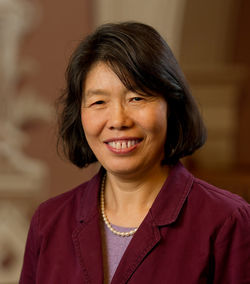报告题目:Resource Management in Cyber-Physical Systems
报告人:Xiaobo Sharon Hu 教授
报告时间:2016年7月12日10:30-11: 30
报告地点:中北校区数学馆201

报告摘要:
A cyber-physical system (CPS) is a system built from close integration of computational fabrics and physical components. Examples of such systems include avionic systems, industrial controland civil infrastructure monitoring. In a CPS, sensors and actuators are used to monitor and control the physical components while the computational fabrics determine the control values for the actuators based on the sensed data. All CPSs require timely delivery of both information from sensors to the computing fabrics and control signals from the computing fabrics to actuators. Managing the limited resources (e.g., computation power and communication bandwidth) to meet the timing requirements in a CPS is a challenging task. Even more challenging is thatCPSs should degrade gracefully in the presence of various external disturbances such as failure in critical civil infrastructures and malicious attacks.
In this talk, after a briefly introduction of the general CPS concept, I discuss several Quality of Service (QoS) metrics for CPSs, the challenges they present to resource management, and some high-level ideas to tackle the challenge. I then focus on one specific problem where a CPS system implemented as a wireless networked control system must deal with unexpected external disturbances. Due to the limited bandwidth in the system, some packets may have to be dropped. I show how a dynamic data-link layer schedule can be constructed to minimize the number of dropped packets while meeting the desired QoS.
报告人简介:
Xiaobo Sharon Hu is a professor in the department of Computer Science and Engineering at the University of Notre Dame, Notre Dame, Indiana, USA. She also holds a joint appointment in the department of Electrical Engineering at the same university. Her research interests include real-time systems, low-power system design, hardware/software codesign, and computing with emerging technologies. She has published more than 250 papers in these areas, and received the Best Paper Award from the ACM/IEEE Design Automation Conference in 2001 and from the IEEE Symposium on Nanoscale Architectures in 2009. Another paper of hers was named one of "The Most Influential Papers of 10 Years Design, Automation, and Test in Europe Conference (DATE)" in 2007. She received the CAREER award from U.S. National Science Foundation. She is the technical program committee Co-Chair of Design Automation Conference in 2014 and 2015 and Programing Chair in 2016. She is currently serving as a guest editor for IEEE Transactions on CAD on a special issue on CAD for Cyber-Physical Systems. She also served as Associate Editor for IEEE Transactions on VLSI, ACM Transactions on Design Automation of Electronic Systems, ACM Transactions on Embedded Computing Systems, and a guest editor for several other journals. She is a fellow of the IEEE.